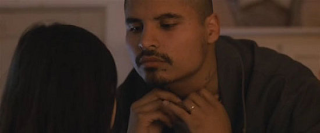Rated R
Nobody feels comfortable
admitting that there are racial stereotypes, but there are. In this film, an
ensemble cast of recognizable actors shows us how those stereotypes affect us
all and how though we may not know each other, we can still affect one another.
Each character in this film is jaded in his/her own way and falls prey to
racial profiling. This is not a “politically correct” film and the filmmakers
wanted it that way. They felt a “PC” film wouldn’t be portraying the truth.
This film takes place in Los
Angeles over the course of thirty-six hours. There are six stories that are
delicately woven together up to the very end, insinuating that we are all
connected. Since their lives cross, it gives you a “small world” feeling. I
like ensemble casts (BIG fan of the hit TV show “Friends”) and I especially
like stories that intertwine. The downside to ensemble casts, and my husband’s
argument, is that because there are no true lead characters, one can’t get
truly invested in someone’s plot (or plight) before being whisked off to
another scenario. I believe this film does it well. You are concerned for each
character and invested in their decisions and actions.
I’ll admit I walked away from
my first viewing saying it was okaaaay. I got more out of it this time around
and am glad I “had” to watch it for this challenge. I was put off by the racism
and violence the first time. Now I realize that’s exactly what the director
wanted. In watching the special features on the DVD, I learned that the
writer/director wanted to make a film about strangers affecting strangers- how
a person can affect another without knowing or even touching them. He knew the
views could/would be polarizing but he believes that when people get angry,
they start talking, and it’s when they start talking, that issues can start to
be resolved. Most importantly, he wanted us to question, “Is this about me?”
Sadly, I don’t think we’re anywhere close to getting issues of racism and
prejudice resolved. We’ve made progress, yes, but the task ahead is monumental.
Don Cheadle, who plays a
detective in the film, told an interviewer “You want to laugh but you ask
yourself, ‘should I laugh? Why or why not? A movie that makes you think or
question is always good’.” Sandra Bullock, who plays an uptight upper-class
housewife in the film, added that “we’re not safe from ourselves and our
prejudices”. Don is right on… some of the lines in the film reflect extreme
stereotypes and are funny but you war with yourself as to whether laughing is
appropriate- for that reason, I’m glad I didn’t see this in a packed theatre.
Rapper Ludacris plays one of
the ensemble and his character runs his mouth like he’s got society all figured
out. The beauty of this film is that every character walks away having learned
something and been impacted. There is no “happy” ending, but knowing that each
life is changed appeases that.
The theme of “crashing” is
particularly evident in this movie and I wouldn’t really call it symbolic- it’s
just obvious. Cheadle’s character even states in the beginning of the film that
we are so desperate for human touch that eventually we will just crash into
each other.
This incredibly low-budget film
was up against “Brokeback Mountain” (highest-grossing film this year), “Capote”,
“Good Night, and Good Luck”, and “Munich”. I’ve seen two of those and wasn’t a
fan of either. Don’t ask me why “Walk the Line” or “Cinderella Man” weren’t
nominated! (Another one of my favorites this year was the winning documentary “March
of the Penguins”.) No one film was a top-nominated film and all six top awards
were split between six winners (Best Picture, Director, Actor, Actress,
Supporting Actor, and Supporting Actor). “Crash” walked away with three awards
from its six nominations, including the deserving Best Original Screenplay. Audiences
were a little caught off guard about its major win since it wasn’t even up for
nomination at the Golden Globes (which is usually a good predictor of the
winners at the Oscars).
I think the picture on the movie poster was an interesting pick. It may seem like such a random shot to put up there to advertise your movie, but the more I thought about it, the more I appreciated what it represented. The repercussions of our actions can be serious. Misunderstandings happen all the time. Hopefully, we can be blessed with second chances when we realize our wrongdoings.
FAVORITE SCENES:
One of the characters is in a
car crash and a cop, who she unfortunately had an incident with before, is
first on the scene to rescue her. She refuses to let him help her, and part of
you can’t blame her. But then you see a shift take place in each character, and
I think it’s pretty powerful to witness.
Michael Pena places the role of
a working father and has a couple scenes with his little daughter that just
melt your heart… like this one where he takes off his invisible protective cape
so that she can wear it and have nothing to be afraid of.
LESSONS LEARNED:
Exactly what Sandra said: We
are not safe from ourselves and our prejudices.
Think before you speak. Your words, though perhaps unintentionally, may hurt
someone.
Stand up against racism. Have a no-tolerance policy about speaking ill of a certain
race, religion, etc.
Do your part to make this
world a more peaceful and accepting place to live.
Every person has their own
fears, anxieties, and insecurities. That’s
another thing that connects us all as human beings.
Try to go into new
situations with an open mind (including
watching new films).











